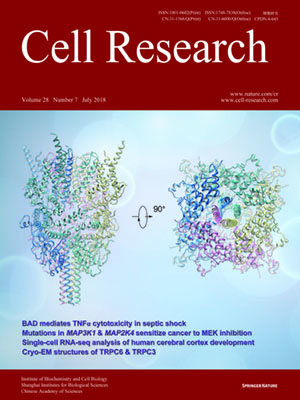
Volume 28, No 7, Jul 2018
ISSN: 1001-0602
EISSN: 1748-7838 2018
impact factor 17.848*
(Clarivate Analytics, 2019)
Volume 28 Issue 7, July 2018: 775-778 | Open Access
LETTERS TO THE EDITOR
Embryonic senescent cells re-enter cell cycle and contribute to tissues after birth
Yi Li 1,2, Huan Zhao 1,2, Xiuzhen Huang 1,2, Juan Tang 1,2,Shaohua Zhang 1, Yan Li 1,2, Xiuxiu Liu 1, Lingjuan He 1,2,Zhengyu Ju 3, Kathy O. Lui 4 and Bin Zhou 1,2,3,5
1State Key Laboratory of Cell Biology, CAS Center for Excellence in Molecular Cell Science, Institute of Biochemistry and Cell Biology, Shanghai Institutes for Biological Sciences, University of Chinese Academy of Sciences, Chinese Academy of Sciences, Shanghai 200031, China; 2Key Laboratory of Nutrition and Metabolism,Institute for Nutritional Sciences, Shanghai Institutes for Biological Sciences, University of Chinese Academy of Sciences, Chinese Academy of Sciences, Shanghai 200031, China; 3Key Laboratory of Regenerative Medicine of Ministry of Education, Institute of Aging and Regenerative Medicine, Jinan University, Guangzhou,Guangdong 510632, China; 4Department of Chemical Pathology, Li Ka Shing Institute of Health Sciences, The Chinese University of Hong Kong, Prince of Wales Hospital, Shatin, Hong Kong SAR, China and 5School of Life Science and Technology, ShanghaiTech University, Shanghai 201210, China
Correspondence: Correspondence: Bin Zhou (zhoubin@sibs.ac.cn)
Dear Editor,
Cellular senescence (or senescence) has been regarded as a stable form of cell cycle arrest by in vitro cell culture experiments.1 Recent studies indicate that senescence is associated with aging and diseases, including cancers.2,3 For instances, it suppresses tumor progression by halting the growth of premalignant cells,4 and promotes wound healing by preventing excessive tissue fibrosis or induction of cell dedifferentiation.5,6 Targeting senescent cells could restore tissue homeostasis in response to aging, chemotoxicity, or injury.7 In addition to these pathological conditions in adults, cellular senescence also occurs in physiological states such as mammalian mouse8,9 and human10,11 embryonic development. Embryonic senescent cells have been reported to be non-proliferative and subjected to clearance from tissues after apoptosis at late embryonic stage.8,9 However, the interpretation for clearance of senescent cells at late embryonic stage is based on the disappearance of Cdkn1a (P21) expression and senescence-associated beta-galactosidase (SAβ-Gal) activity,8,9 two commonly used senescence markers in the field. Currently, there is no genetic fate mapping evidence for senescent cell fate in vivo. By lineage tracing of P21+ senescent cells, we found that embryonic senescent cells labeled at mid-embryonic stage gradually lost P21 expression and SAβ-Gal activity at late embryonic stage. Unexpectedly, some of the previously labeled senescent cells re-entered the cell cycle and proliferated in situ. Moreover, these previously labeled senescent cells were not cleared at late embryonic stage and remained in the tissue after birth. This study unravels in vivo senescent cell fates during embryogenesis, indicating their potential plasticity.
https://doi.org/10.1038/s41422-
FULL TEXT | PDF
Browse 2374


